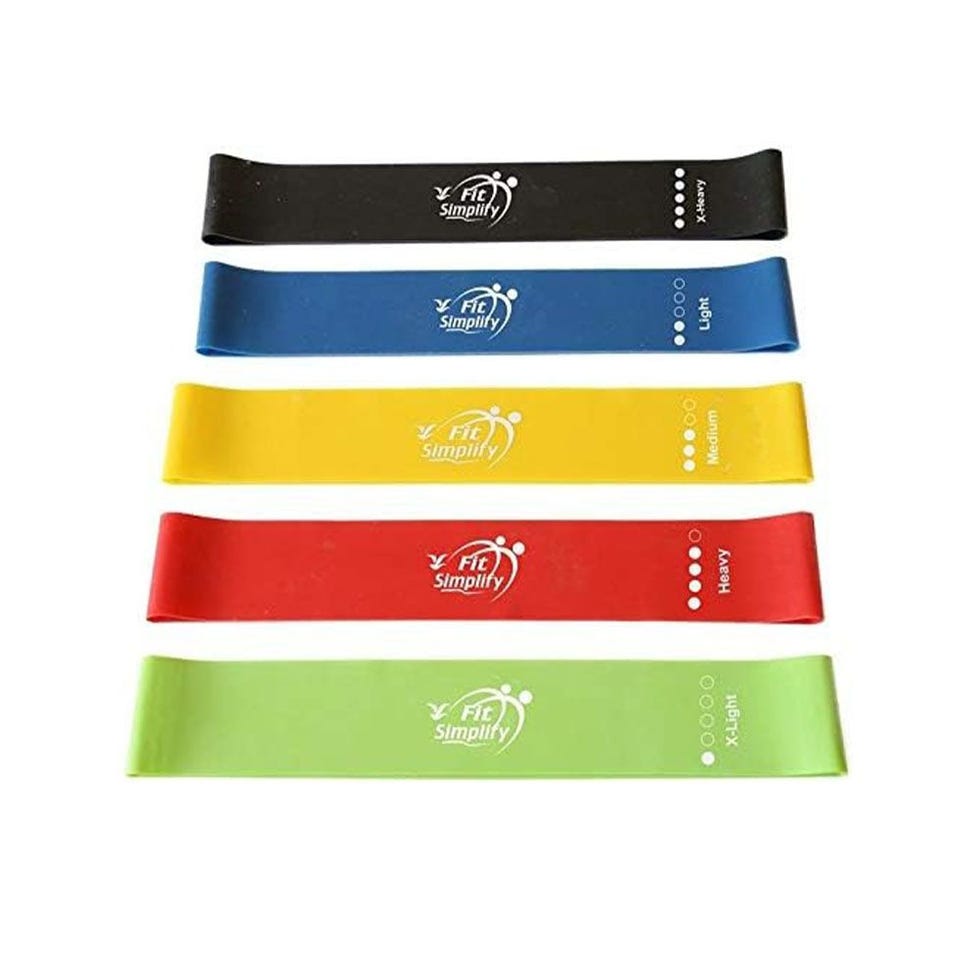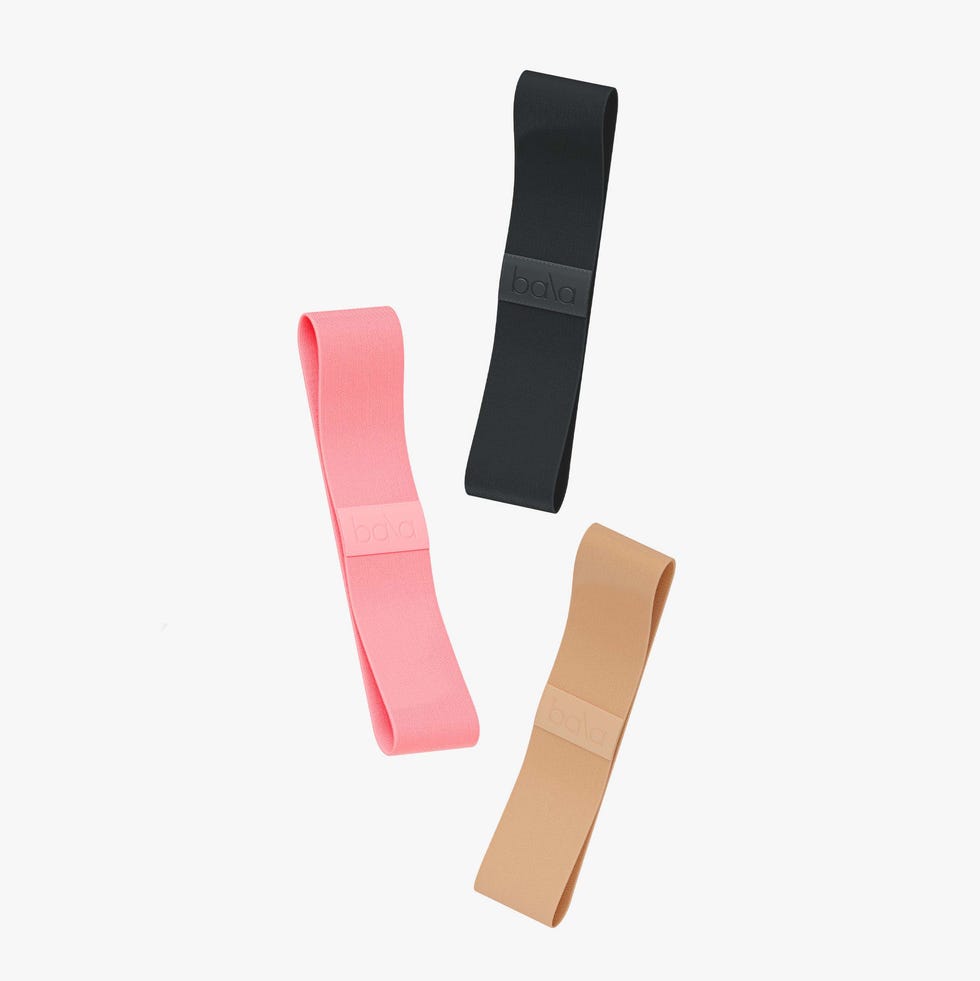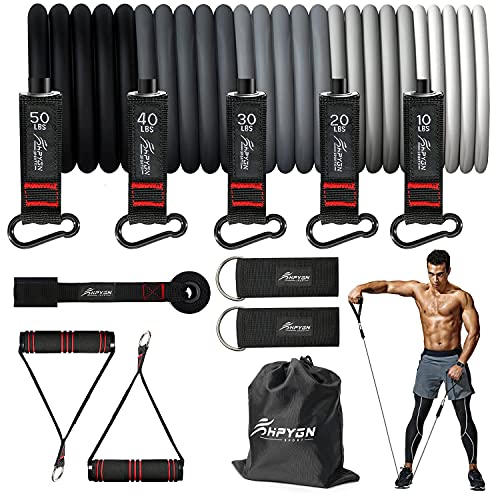You might think of resistance bands as tools reserved for physical therapy clinics or rehab settings, but don’t underestimate their potential for helping you build strength and acquire new skills in the gym.
Resistance bands offer benefits that apply to all fitness levels. They’re one of the best ways to get stronger, improve mobility, or add intensity to your workouts without the need for heavy home gym equipment, says Corrine Carnation, CPT, a personal and group fitness trainer.
“Resistance bands are the secret ingredient to making everything feel a little more intense,” says Carnation. This could mean increasing the challenge for bodyweight exercises like squats or amplifying the difficulty of moves you’d usually do with only free weights. On the flip side, when used strategically, bands can also make certain bodyweight moves more accessible by providing assistance—such as supporting your weight during pullups or pushups.
In this guide, we’ll take you through everything you need to know about using resistance bands, from their role in resistance training to how they compare to free weights. Whether you’re working out at home, at the gym, or on the go, this guide will show why resistance bands are a fitness must-have for all levels and ages.
Meet the expert: Corrine Carnation, CPT, is a personal and group trainer at Equinox and the creator of Better You, Better Living, a virtual training program.
What To Use Resistance Bands For
Resistance bands are small-but-mighty tools that can transform almost any exercise by offering resistance or support, depending on your needs and how you use them. “You can use them to activate specific muscles during a warm-up, build muscle in workouts, improve flexibility in cooldowns, make an exercise harder, or even make practicing a new skill easier,” says Carnation. They come in various forms, including long bands, loops, and tubes with handles, each designed for different types of exercises (more on this coming up!).
Warm-Ups And Mobility Work
Resistance bands are excellent for activating and engaging muscles as well as practicing mobility. When used before a workout, bands prepare your body for heavier or more dynamic movements by priming muscles to “fire up” without overexerting them. For example, try lateral band walks or band pull-aparts before a full-body lifting session to prime your hips and shoulders. This activation also helps improve joint mobility, says Carnation, reducing the risk of injury once you start adding heavier loads or moving with more intensity.
Targeted Strength Gains
Bands allow you to tailor exercises to specific muscle groups, says Carnation. For example, use a long loop band for rows or a mini band for glute bridges to target the upper and lower body, respectively. Resistance bands can also add tension to familiar exercises like squats, turning them into more challenging strength-building moves without the need for heavy weights. Plus, bands are ideal for isolating muscles like the glutes, shoulders, or core, making them great for focused strength work, she says.
Building Muscular Endurance
“Unlike heavy weights, which are great for increasing maximal strength and power, the dynamic resistance that bands offer is perfect for building endurance in the muscles,” says Carnation. By maintaining tension throughout the entire range of motion, they challenge your muscles for longer durations, helping to build stamina and improve muscle longevity. For toning or endurance-focused workouts, try high-rep banded exercises like lateral raises or banded lunges to keep muscles engaged over time, says Carnation.
On-The-Go Workouts
Resistance bands are compact and lightweight, making them perfect for travel or at-home workouts. You can take them just about anywhere, allowing for a quick, effective workout session whether you’re on vacation, on a business trip, or just looking to fit in some movement at home. A mini band can enhance bodyweight exercises like squats or planks, while a long loop band can serve as your all-in-one tool for rows, presses, and stretches, says Carnation.
Injury Prevention And Rehabilitation
Resistance bands shine in rehabilitation settings, where their controlled and gentle resistance is ideal for injury recovery. You can use them to strengthen specific muscles and joints, get your range of motion back, and slowly rebuild mobility. For example, they’re amazing for targeting the rotator cuff if you’re dealing with a shoulder injury or for doing low-impact exercises to help a banged-up knee feel stronger.
Adding Variety To Your Routine
Resistance bands are a great way to shake up your workouts, adding new challenges to break through plateaus or engage your muscles in fresh ways. For instance, if you’ve maxed out on bodyweight squats, adding a mini band around your thighs can increase intensity and activate muscles differently. Bands can also help make traditionally challenging exercises more accessible, such as using a long loop band for assisted pullups or triceps dips. “You can get creative with bands—they’re great for both pushing limits and providing support,” says Carnation.
Pro tip: Start by incorporating bands into exercises you already know, such as banded squats or pushups, to experience how they impact the movement, says Carnation. Then, explore their full potential by trying band-specific moves like lateral walks, resistance rows, or assisted pullups.
How To Use 5 Popular Band Types
Resistance bands are fairly straightforward to use, but choosing the right one for you, and knowing how to properly utilize it in a workout, makes a huge difference. If you’re wondering which type to try first, it depends on your goals. Here’s what you need to know:
Mini Loop Band
What it is: Mini loop bands are small, circular resistance bands typically made of latex or synthetic materials. They’re lightweight, portable, and provide varying levels of tension.
What it’s good for: These bands are perfect for moves like glute bridges or fire hydrants to really isolate lower-body muscles like glutes, hamstrings, and quads, says Carnation. They also work well for activating muscles before a workout or adding resistance to bodyweight exercises. Compared to fabric loop bands, mini bands are often more affordable, but tend to roll more easily and provide less consistent tension.
How to use it: Place the band around your thighs, just above or below your knees, to add resistance to exercises like squats or glute bridges. Keep in mind, the further the band is from your hips, the more challenging the movement becomes, says Carnation. Try a squat with a mini band around your thighs to really fire up your glutes, or you can even use them around your wrists for upper-body stability work, like planks.
Long Loop Band
What it is: Long loop bands are longer and thicker than mini bands, offering more resistance and versatility for full-body moves. They’re usually made of rubber or latex and can be flat or tubular.
What it’s good for: Thanks to their size and tension, these bands are ideal for full-body, compound movements like squats, rows, or presses, says Carnation. They can also assist with challenging moves like pullups or dips. Compared to bands with handles, long loop bands offer more adaptability but can be harder to grip without additional attachments.
How to use it: Step on one end of the band with your feet and pull or press against the other end with your hands for strength exercises like overhead presses or rows, says Carnation. Loop it around a sturdy anchor point for assisted pullups or use it in place of dumbbells to mimic weightlifting movements.
Fabric Loop Band
What it is: Fabric loop bands are thick, woven resistance bands designed for durability and comfort. Unlike rubber mini bands, they’re less likely to roll up, pinch your skin, or tear.
What it’s good for: These bands shine during lower-body exercises, especially for moves that need consistent tension, like lateral band walks, squats, or hip thrusts. Compared to mini loop bands, fabric bands provide more consistent resistance and are generally more comfortable to use.
How to use it: Use a fabric band the same way you’d use a mini band—place it around your thighs or ankles to add resistance to lower-body moves. Their non-slip material helps keep them in place during dynamic exercises like fire hydrants or glute extensions in the quadruped position, says Carnation.
Band With Handles
What it is: Bands with handles are resistance bands with ergonomic grips on each end that you can grab onto. They’re often tubular and come in a variety of different resistance levels and lengths.
What it’s good for: These bands are stellar for upper-body strength exercises, like biceps curls, chest presses, or rows, says Carnation. Compared to long loop bands, they’re easier to hold and control, making them beginner-friendly and ideal for focused strength training, she says.
How to use it: Anchor the band to a door or secure object, or stand on the middle of the band to perform exercises like rows, front raises, or triceps kickbacks, says Carnation. The handles provide a solid grip, reducing the strain on your hands during pulling or pressing movements.
Long (Non-Looped) Band
What it is: Non-looped bands are long, flat strips of resistance material, often made of rubber or synthetic latex-free materials. They’re lightweight and can be cut to any desired length.
What it’s good for: These bands are most commonly used in physical therapy, stretching, or mobility work (if you’ve ever been to PT, you’ve probably used one before). They’re usually light in resistance, and ideal for targeting smaller muscle groups and improving range of motion, says Carnation. They offer more customization in length and tension than looped bands, but are less suited for dynamic, compound exercises.
How to use it: Hold the ends of the band in your hands or tie it around a sturdy object to perform moves like shoulder stretches, seated rows, or hamstring stretches, says Carnation. You can also wrap it around your feet for gentle resistance during leg exercises or rehab work.
Top Resistance Bands To Try
How To Choose The Appropriate Band Tension
You want enough resistance to provide a challenge, but not so much that it hinders your form or control when performing an exercise. As a beginner, start with something light to get the hang of things.
If the band feels too easy—allowing you to complete more than 15 repetitions without much effort—try moving on to a heavier resistance. On the flip side, if the band makes it difficult to complete even five to eight repetitions or compromises your form, opt for a lighter option.
Keep in mind that, for multi-joint movements like squats or rows, you may need a stronger band, while exercises targeting smaller muscle groups like the rotator cuff muscles (stabilizing muscles in the shoulder joint) often require less tension. Some bands are color-coded to indicate tension levels, making it easy to progress as you build strength but this can vary from brand to brand.
Resistance Bands Vs. Free Weights: Which Is Better?
Unlike free weights, which can feel intimidating and take up more space, resistance bands provide a gentle, low-risk way to ease into strength training. This makes them ideal for beginners who want to build confidence and learn proper form and muscle activation before adding heavier resistance via free weights. Resistance bands and free weights both have a place in strength training, but knowing more about each form of resistance can help you decide which is best for you based on your goals. Carnation explains the three major differences:
- Size and level of resistance. Free weights are heavy, bulky, and require dedicated storage space, which can make them less accessible for home workouts or travel. Resistance bands, on the other hand, are lightweight, compact, and easy to store or pack in a bag. This portability makes them perfect for people with limited space or those who want to stay active on the go. Whether you’re working out in a hotel room or squeezing in a quick session at home, bands are a practical and convenient option.
- Type of resistance. Free weights use gravity to create consistent resistance throughout a movement, making them great for providing heavy loads to build pure strength and muscle size with exercises like squats and deadlifts. Resistance bands, however, offer variable resistance—the tension increases as the band stretches, making movements harder as you go. “They create more tension at certain points in a movement, keeping your muscles working longer,” Carnation. For beginners, this gradual resistance helps build control, stability, and muscular endurance while being easier on the joints.
- Level of resistance. While free weights let you adjust the load by swapping out plates or using heavier dumbbells, bands offer the added ability to adjust resistance mid-movement by changing how much you stretch the band. This variability makes bands particularly good for targeting smaller muscles or fine-tuning an exercise’s difficulty. For beginners, bands are a forgiving and adjustable way to experiment with added resistance without the need for heavy equipment.
To summarize the differences: If you’re looking for lower resistance levels to improve mobility, rehab a painful injury or trying to isolate and strengthen a muscle, resistance bands are a great, portable option. “Bands are awesome for when you want variety, more muscle activation, or less impact on joints,” Carnation says. But if building pure strength and putting on muscle mass is the priority, incorporating weights is a good option. A balanced approach can even combine both for well-rounded fitness progress, she says.
Can you build muscle only using bands?
Yes, you can build muscle using only bands, but it depends on your goals and how you use them, says Carnation. Bands provide enough resistance to challenge your muscles and stimulate growth, especially for beginners or those returning to exercise. In fact, training with bands can deliver strength gains comparable to conventional gym equipment of equivalent resistance, according to a 2019 study published in SAGE Open Medicine.
That said, if your goal is to gain significant muscle size (hypertrophy) or maximum strength, you may eventually need heavier resistance than bands alone can provide. For most people, combining bands with other forms of resistance—like free weights or weight machines—offers the best results, she says.
Common Resistance Band Mistakes
While resistance bands are beginner-friendly, they can present challenges if not used properly. Avoid these common mistakes to ensure your workouts are safe and effective:
- Failing to secure the band: “I’ll never forget my first banded slingshot to the face,” says Carnation. “It happens to the best of us, but it can be avoided. Make sure you anchor the band to something secure and steady.” Whether you’re attaching the band to a door frame, pole, or your foot, double-check the anchor point to avoid it snapping loose during your workout.
- Using the wrong tension: Bands that are too light won’t challenge your muscles, while overly heavy bands can compromise your form. Gauge your strength level to make sure the tension allows you to complete your reps with good control but enough effort to feel the burn.
- Improper placement: Bands that are not positioned correctly can roll up or dig into your skin, making exercises uncomfortable. For moves like squats or glute bridges, ensure the band sits flat and snug around your thighs or ankles, depending on the exercise.
- Neglecting form: Resistance bands require you to control the tension throughout the movement, so it’s always good to prioritize slow, controlled movements over resistance or rep count. If you are unsure where to begin, try working with a personal trainer or physical therapist to get you on the right track and monitor form.
- Skipping regular band checks: Over time, bands can wear out and lose elasticity, increasing the risk of snapping and becoming less effective. Check your bands for cracks or weak spots before each workout, especially if they’ve been used for a while. And don’t forget to progress to new ones when the time is right.
By avoiding these mistakes and taking a few precautions, you’ll get the most out of your resistance band workouts without any unwelcome surprises.
A 30-Day Resistance Band Challenge To Try
Ready to put your resistance bands to good use? Check out our 30-Day Resistance Band Challenge, designed to help you build strength, improve mobility, and stay consistent with quick, effective workouts. Each day focuses on a specific set of exercises that target your upper body, lower body, or core, using just a mini band. It’s perfect for beginners and experienced fitness enthusiasts alike. With guided instructions and a mix of fun, dynamic moves, this challenge will help you see progress in just one month.
Rachel Tavel is a doctor of physical therapy, strength and conditioning specialist certified by the National Strength and Conditioning Association, and writer. Her writing has been published in Forbes, Fortune, Men’s Health, Women’s Health, Runner’s World, SELF, Bicycling Magazine, The Huffington Post, and more. She co-authored the book “Stretch Yourself Healthy Guide: Easy Routines to Relieve Pain, Boost Energy, and Feel Refreshed” (Prevention, 2020) and is a Forbes Health Advisory Board Member. Prior to becoming a physical therapist, Rachel was a travel writer living and traveling throughout South America. Connect: , , Email: .









